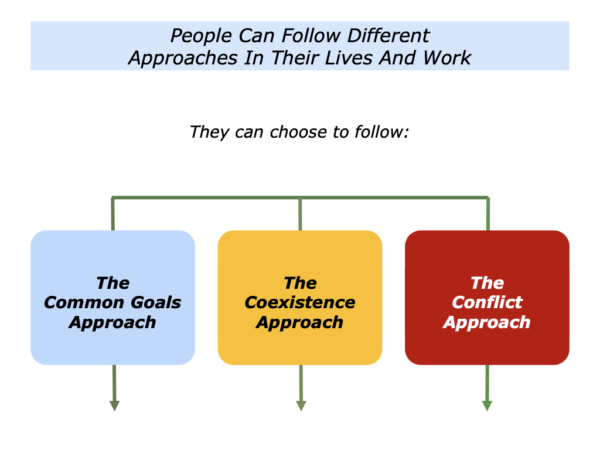
There are many ways for people to live and work together. They can choose to follow, for example, the common goals approach, the coexistence approach or the conflict approach.
Different people follow these routes in different ways. The route they take has consequences for both for themselves and other people. Let’s explore these approaches.
The Common Goals Approach
This route involves people choosing to work together towards common goals. They can do this when working as a family, team, organisation society or as a group of nations.
Some leaders take this approach in organisations. The leaders clarify and communicate the organisation’s purpose, principles and picture of success. They also show the benefits of achieving the goals.
They then invite people to reflect and decide if they want to work towards achieving the common goals. If so, they make clear contracts about people’s best contributions towards achieving the picture of success.
Some leaders take this approach in societies. They recognise that many people want similar things in life. They also want to maintain or improve their health, hope and happiness.
Such leaders then focus on setting goals that provide people with the basic materials for life – such as safety, food and shelter. They also give people the opportunity to shape their futures in a positive way.
There are many ways to set common goals. Let’s explore one approach that is sometimes used in potential conflict situations.
The Third Side Approach
To Setting Common Goals
The following section is based on work done by William Ury, who has helped many people to find solutions to conflicts. One approach he uses is to encourage people to focus on what he calls the Third Side.
William explains that people sometimes get into difficulties because they sit opposite each other and fight for their own agendas. Each party says the equivalent of: “I am right,” or “Our side is right.” “You are wrong.” These are the First and Second Sides.
William says that we do not have to get into fighting by taking the First or Second sides. He says that we have a powerful alternative – the Third Side. He says:
The Third Side approach can transform our daily battles into creative cooperation. We can apply this at home, in our work and across the world.
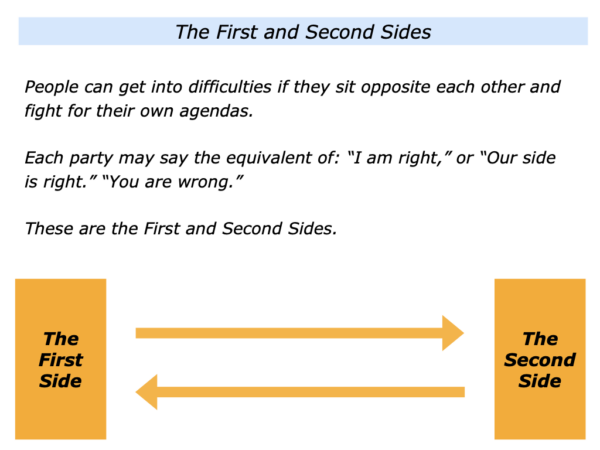
People are more likely to achieve a positive outcome if they can sit side-by-side and look together towards a Third Side. This is the greater What and Why.
People often get into arguments about the How, but it is important to focus on the higher purpose. This purpose may be, for example, the children’s welfare after a divorce, the team’s goals or the kind of world we want to pass on to future generations.
When working with divorcing parents, for example, you will start by focusing on the shared aims they have in common. They may get into arguments and say that:
“We have nothing in common.”
They blame each other and say that things would be better if the other person changed. At a certain point, however, you may say something like the following.
“You say you have little in common, but do you both want the best for your children?”
They will probably agree that they do, but may disagree on how to achieve those aims. You may then say something like:
“Looking ahead, let’s explore the actual words you would like your children to be saying in 10 years about the way you managed the divorce.
“For example, you may want them to be saying things like:
‘Mum and Dad behaved in a good way when they went apart. They never used us as pawns or blamed us.
‘They continued to encourage us and helped us to develop. We now have two homes where we can go and feel at ease.
‘Mum and Dad managed the difficult situation in a positive way.’
The Third Side approach can be applied in many situations. The key is to build on what people have in common and agree on a set of goals or a picture of success. This becomes the Third Side.
Providing people are clear on the agreed overall goals, you can then say things like:
“As far as I understand it, these are the goals to achieve. This is the picture of success.
“These are the benefits – for the various parties- of achieving the goals.
“Is this something you want to work towards achieving?”
You can then aim to set a specific goal and get a quick success. This helps to build confidence and move on to the next goal.
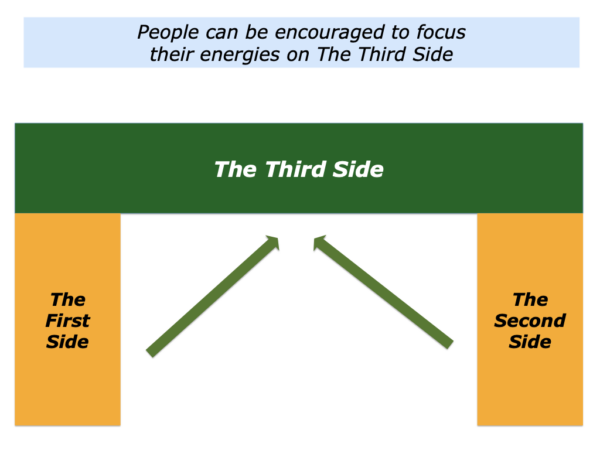
Mediators recognise that it can take time to get to this point. Bearing this in mind, let’s explore this approach in more depth.
Clarifying The Common
Goals – The Third Side
Imagine that you have been asked to facilitate a discussion about enabling people to work together towards a common goal. The first step is to clarify the potential Third Side.
This is what I was asked to do when invited to work with two departmental heads in a company. The Chief Executive was losing patience with the two teams that were supposed to work together to achieve the company’s goals.
The challenge was that each team focused only on their own targets. When asked about cross-functional work, they blamed each other for failures. This downward spiral affected the service given to customers and the whole company performance.
Bearing this in mind, I met the Chief Executive to clarify the real results to achieve. He was crystal clear on what he wanted them to contribute towards achieving the company’s picture of success.
This called for the respective departments to implement certain strategies to work together, deliver high levels of customer satisfaction and, in the process, contribute to achieving the company’s goals.
The key would be to encourage the departmental heads to focus on these outcomes. They had forgotten to focus on the real What – the things they must deliver to achieve the company’s picture of success. Instead they had fallen into arguments about the How.
This sounds relatively straight-forward. But what happens when you don’t have an authority – such as a CEO – who can let people know about the desired Third Side?
Clarifying What Each Party Wants
And Building On Common Ground
One approach is to meet with each party and clarify what each of them wants. The keys will be:
To clarify their respective aims;
To then build on common ground.
Each party may want to begin by expressing their feelings about the situation. When appropriate, however, you can invite them to focus on the future.
Good mediators show that they recognise people’s feelings. They then encourage people to channel their energy towards finding solutions. One approach is to invite them to look to the future. It is to ask questions around the following themes.
“Looking ahead, what would you like to happen? What are the real results you want to achieve? What is your picture of success?”
Mediators listen without judgement and play back what they are hearing. If appropriate, however, they sometimes invite people to express their ideas in a positive way.
If one party says that they want others to stop doing something, for example, the mediator invites them to say what they would like the others to do instead.
Towards the end of the conversation the mediator will summarise what they believe to be a party’s goals. They may say something along the following lines.
“As far as I understand it, the goals you would like to achieve are:
To …
To …
To …
“Is that right? Are there any other things that you would like to happen in the future?”
Imagine that you have taken this approach. You will have met with each party and clarified their aims.
The next step is to bring people together and focus on some of the common goals. Some people may try to draw you into arguing about the differences, but return to the similarities.
Keep bringing people back to the What – the real results they want to achieve. This can be challenging, because people often want to get into arguing about the How. When helping people, it can be useful to bear in mind some of the following guidelines.
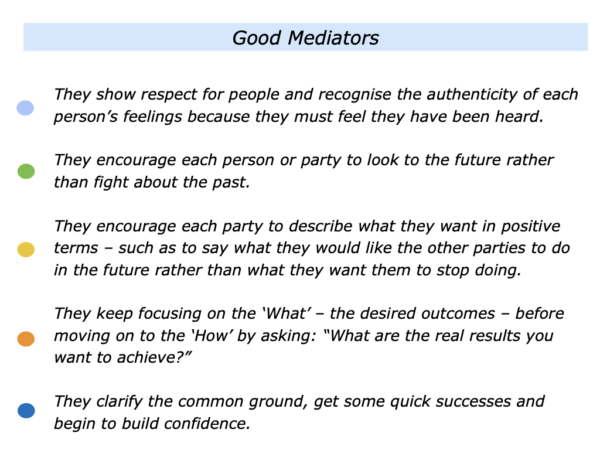
Building On The
Common Ground
The next step is to make sure the parties are prepared to build on the common ground. Sometimes this calls for again explaining it is important to get some quick successes rather than rushing into trying to solve deep differences.
Looking at the work with the two departmental heads, both had worked with me before so they knew the session would be positive. During the meeting it was important to take the following steps.
To create an encouraging environment and explain that I was sure we could pool our resources to find a win-win;
To explain that, if they were open to it, we would explore how they could be supported to combine their talents to achieve the company’s goals;
To put these goals in front of us so that we were literally all on the same side and looking together at the company’s picture of success.
Going deeper, I explained we had been tasked with working together to find solutions. Were they willing to work towards satisfying the customers and achieving the company’s goals?
“Yes, of course we are willing,” was the joint reply, followed by a few caveats.
Taking Steps To Achieve
The Common Goals
Success builds confidence. So it is vital to focus on specific things that people can do to deliver some early wins. This is what happened with the two departmental heads in the company. They made specific action plans that involved them co-operating:
To deliver superb service to the customer;
To produce success stories that enhanced the reputation of the customer and company;
To proactively keep the Chief Executive informed about their contribution towards achieving the company’s picture of success.
The two people worked together to get some quick wins. They then developed a pattern of building on what they had in common rather than only focusing on differences. This laid the groundwork for helping them to achieve ongoing success.
There are many ways to encourage people to focus on common goals. Bearing this in mind, however, let’s explore another approach that people take towards living and working together.
The Coexistence Approach
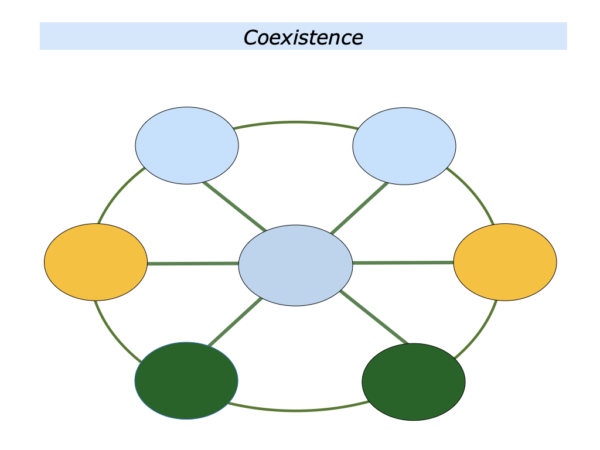
Some people follow the coexistence way of living or working together. They respect each other, accept differences and get on with living their lives. There are several definitions for coexistence. One of these is:
To live in peace with other as a matter of policy.
Different people follow this approach in different ways. It may be followed, for example:
By parents who divorce but cooperate in raising their children … By people from different faiths or belief systems … By people from different backgrounds … By people in different countries.
Such people sometimes build on what they have in common. They may also do some things differently but this is accepted or even encouraged – providing they do not hurt others in the process.
Some companies follow the coexistence approach when they acquire businesses. Whilst other big companies take the complete take over approach and swallow up the other business, some companies aim to get the best of both worlds. They aim:
To integrate some generic systems and functions;
To give the acquired business autonomy – within certain parameters – to build on their strengths;
To make clear contracts with the acquired business about the outcomes they will deliver and their best contribution to the big company.
People who take the coexistence approach aim to live or work together in ways the help rather than hurt others. They are then able to live fruitful lives. Let’s look at another route that is not as beneficial to others.
The Conflict Approach
People who take this route seem addicted to conflict. Some do it because they believe it is the only way to maintain their own existence. This may or may not be the case, but some do it for other reasons.
Some people are power driven and follow the conflict route to maintain their status. They start wars with other countries, criticise other people or scapegoat those who are different.
Such people aim to feel superior and are addicted to win-lose behaviour. They want to win and make sure that other people lose. This can create collateral damage and painful consequences.
Let’s return to your own life and work. Looking ahead, can you think of a situation where you may want to follow either the common goals or coexistence approaches? This could be in your personal or professional life.
If you wish, try tackling the exercise on this theme. This invites you to complete the following sentences.
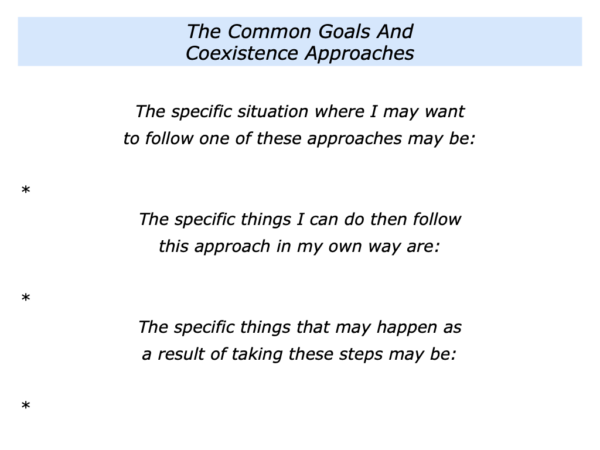






Leave a Reply